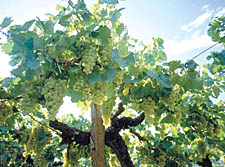
Torrontes grapes growing in the Argentinian sunshine |
Goodbye Chardonnay, or is it merely
au-revoir?
Once much-loved, Chardonnay
has now seemingly fallen out of favour with wine-drinkers
ONLY a few years ago white wine lovers drank Chardonnay.
Wine shelves were packed with the stuff. Almost every country
that wanted to export produced a range of what the experts
described as rich oaky single varietal Chardonnay wine.
Now the Sultana of the shelves has been dethroned and is forced
to compete with an ever growing band of upstart wines. Worse
still, her bottles are being invaded by downmarket peasant
grape varieties; such is the case with the Argentinean made
Inti Chardonnay/Torrontes.
According to an ancient Inca myth Inti was the Sun god and
the ancestor of the Incas, and its makers have, they say,
captured the essence of the Sun and put it in a bottle. Sainsbury’s
are passing it on to us at £2.99 (reduced from £5.99).
Here Chardonnay is blended with Torrontes a local and until
now unheard of Argentinian grape. Torrantes is described as
containing a tumultuous outpouring of tropical fruit, candied
peaches, lychees, rose petals and other floral hints.
It rushes into the mouth, they say, with an extra zing of
spice and acidity. Wine drinkers may be searching for new
wines – especially white – but it’s unlikely
they will find many bottles of a single varietal Torrontes
wine in the UK.
Torontes is the most widely grown grape in Argentina and makes
genuine Argentinian wine whose individuality can seep through
even when seriously diluted by oceans of formulistic Chardonnay.
But it, and other local vines, are being dug up and replaced
by the usual International varieties such as Chardonnay and
Sauvignon Blanc. Perversely, growers and wineries in countries
where these grapes have grown for generations are closing
down due to lack of demand. This process is taking place throughout
the wine making world, local traditional wines are being ignored
and consigned to history.
Tesco’s may claim to offer 750 wines but most of these
are made from a tiny percentage of the available grape varieties
and are produced by an ever decreasing number of companies.
Products such as the above mentioned Inti Chardonnay/Torrontes
are an attempt to respond to some of these criticisms and
although not the full answer, they do give some kind of local
colour to what would be a bland formula wine.
We know Chardonnay is losing its appeal, even so at a recent
tasting organised for the mayor of Islington’s International
Islington initiative (Islington Tribune February 27), we were
surprised to find the participants reluctant to choose a McLaren
Vale Chardonnay even though it was their favourite among the
wines being tasted. Sophisticated and intelligent wine drinkers
don’t like to admit to drinking this stuff any more.
Chardonnay it seems is the new Liebfraumilch.
The new trendy kid on the shelf is supposedly Sauvignon Blanc
wines and are strongly backed by the nation’s wine writers,
but facing stiff competition from Pinot Grigio. For those
who like outsiders, watch those Germans – their wines
are on the up. This is no blitzkrieg just a gentle creeping
back onto the shelves after years in the wine making wilderness.
• In an article in The Times on January 14, the paper’s
wine columnist Jane MacQuitty brushes aside criticisms of
supermarkets made in the New Journal before Christmas (Supermarket
wine rules OK!).
In our article we were trying to draw attention to the use
of language in lifestyle supplements and weekend reviews,
and demonstrate that this type of description does not provide
an adequate basis on which to choose a wine.
We argued this reinforces an existing pre-occupation with
New World wines from a narrow range of large producers, thereby
restricting the choice offered on supermarket shelves.
Wine writers play a crucial role informing and advising us
what to buy. This is a debate that can’t be dismissed
so easily.
|

